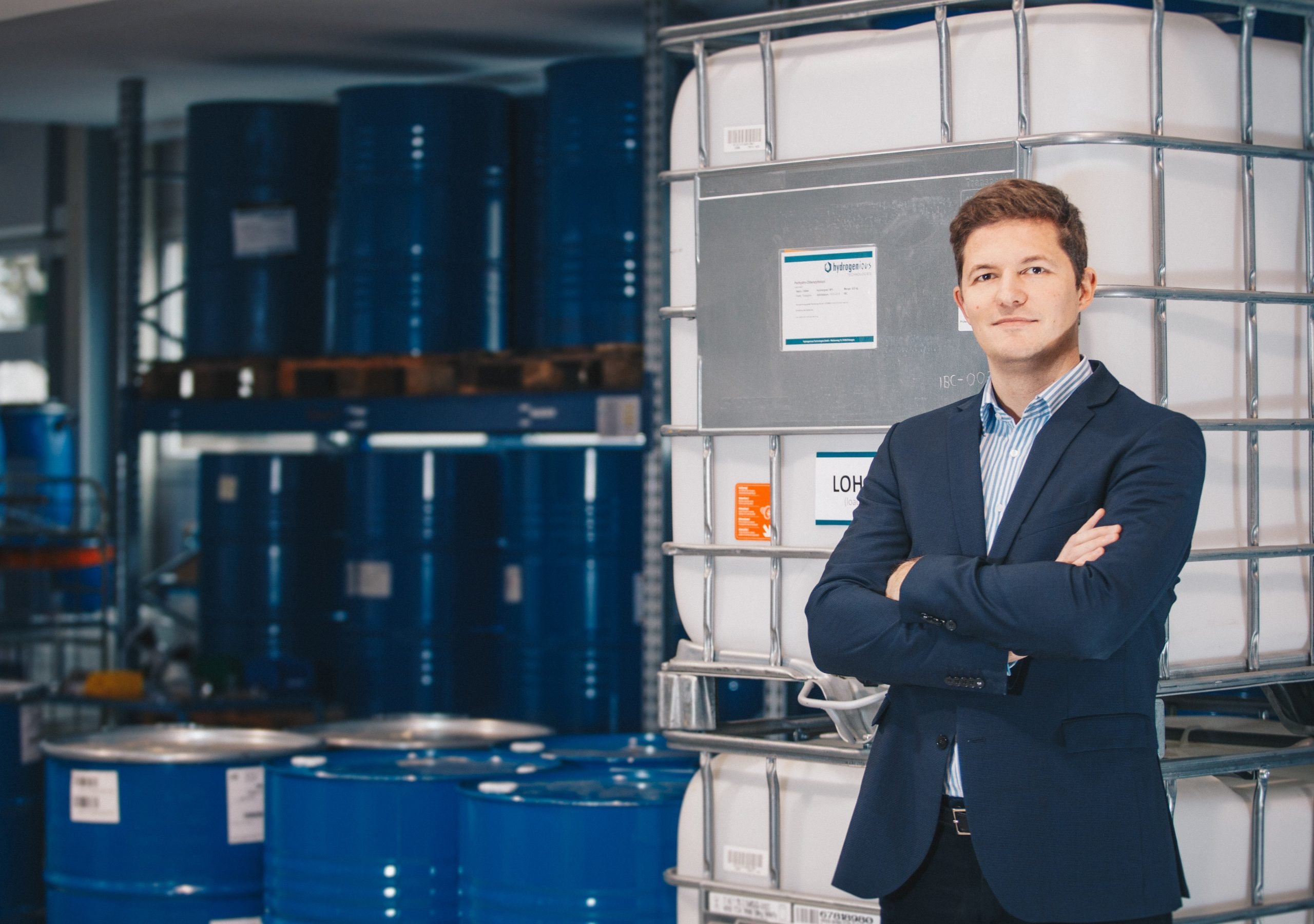
Hydrogenious is the product of a university research team that already had faith in hydrogen when it still wasn’t really relevant in Germany. They have managed to find a way to store and transport the hard-to-handle hydrogen in a practical way. After a successful financing round, they now want to establish their LOHC technology worldwide and “make hydrogen the ‘crude oil’ of the regenerative era”, says co-founder Daniel Teichmann.
In terms of mass, hydrogen has three times the energy content of gasoline. This is an impressive feature for an energy source. However, hydrogen also has the lowest density of all gases and is therefore difficult to handle. It evaporates easily, is flammable and must be stored under high pressure or at low temperatures.
Evaporation and flammability
Hydrogenious LOHC Technologies took up the challenge and solved both evaporation and flammability issues. The start-up company developed a process whereby hydrogen can be stored and transported together with oil (dibenzyltoluene) without risk. The result? The existing infrastructure can be used. Not only the fuel tanks at service stations, but also the pipelines for transportation. This could pave the way for emission-free mobility and industry.
Hydrogenious LOHC Technologies is a spin-off from the Friedrich Alexander Universität Erlangen-Nürnberg. Managing director and co-founder Daniel Teichmann has been working in the field of LOHC (liquid organic hydrogen carriers) since the start of his PhD in 2009. The company was founded in 2013 as a result of a critical technological breakthrough, which was also co-developed by professors Peter Wasserscheid, Wolfgang Arlt and Eberhard Schlücker.
Dewatering system
What was already working under laboratory conditions could be implemented on a technical scale for the first time in 2016. The first LOHC dewatering system was commissioned at the Fraunhofer ILO in Stuttgart. Electrolysis and hydrogenation take place at the main site in Erlagen. The process works as follows:
- The hydrogen is produced with the aid of solar energy using PEM electrolysis,
- Hydrogen is hydrogenated through the chemical bonding of hydrogen molecules to the liquid carrier via catalytic reactions,
- During the dehydrogenation process, catalytic reactions are again used to release the hydrogen molecules from the liquid carrier medium,
- The carrier material is not wasted and can be reused again and again.
Target groups are the chemical industry as well as service stations and the chemical industry. Hydrogenious sells two types of equipment. These are storage facilities for use in hydrogen-producing wind farms for hydrogenation, and the so-called Release Box at service stations and industrial installations for dehydrogenation.

Innovation Origins spoke with Daniel Teichmann:
What is your motivation and what problem does the company resolve?
We believe in hydrogen as a renewable energy source. This motivated us to start the company in 2013. At that time, we could have developed the technology together with industrial partners, but we wanted to be in business.
What has been the biggest obstacle that you have had to overcome? Was there a moment when you wanted to give up?
Giving up never occurred to us and fortunately there was never a reason to give up. However, setting up and developing a business is a huge challenge. At the start, it’s usually a matter of finding funding. In Germany, there is not really an explicit culture when it comes to venture capital. Things are different in the Anglo-Saxon world and in China. Six years ago, hydrogen was not yet playing an important role in Europe. This has changed over the past year. As a university spin-off, we started out with a technology that works at the laboratory level. We first had to bring it up to an industrial level and make it commercially relevant.

What have been the highlights so far?
The successful funding round in July 2019, where we found four partners who not only act as capital providers, but also make a strategic contribution. This was an important milestone in the history of hydrogen-based LOHC technologies.
What are the advantages of your location?
Erlangen is an ideal location for us because of its proximity to the university, whom we also work closely with. In addition, the availability of specialists here is very good. We are also very lucky with our landlords, they’ve provided us with an excellent office and workshop space.
Where will your company be in five years’ time?
We want to progress from our current demonstration level to the realization of large industrial projects. We want to establish a successful global positioning of the LOHC technology. With our technology, hydrogen can then be easily and efficiently transported over long distances. For example, from Africa to Europe. That is how we can make an emission-free industry happen.
What distinguishes your innovation from similar products in the hydrogen energy sector?
Hydrogen has been produced and stored as an industrial gas for one hundred years. Our technology means that using hydrogen in a liquid form is feasible which thereby means it can make use of the existing infrastructure. In this way, we are turning hydrogen into the emission-free fuel of the future. Similar technologies exist in Japan, although they are not exactly the same. We are the technological leaders with our LOHC. As such, we hope to make an important contribution towards combating climate change.
Are you interested in start-ups? Read all articles from our series here.
Also interesting:
TU Eindhoven is bringing hydrogen as a source of energy for households one step closer.
Mobility of the future – battery or hydrogen?
